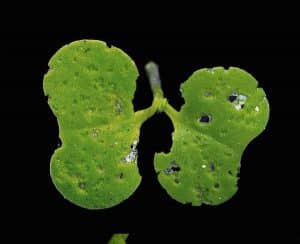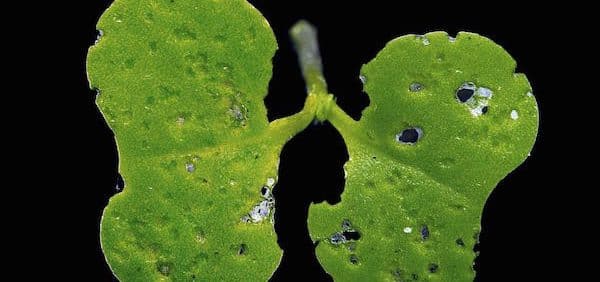The action threshold for flea beetles in canola crops in Canada is an average leaf area loss of 25% or more. The economic thresholds – the point at which foliar insecticide provides an economic benefit – could be when damage reaches 50%, but leaf area loss can reach this stage fairly quickly when flea beetle numbers are high, they are actively feeding, and damage is already at 25%. NOTE: Cotyledon staged plants can withstand up to 50% defoliation (losing 1 whole cotyledon) after 50% it starts to cause harm to the plant.
What does 25% loss mean? If some seedlings have 10% leaf area loss and others have 40% and everything else is somewhere in between, the average is probably around 25%. If leaf area loss is below 25%, but it seems a lot of stems are being chewed up, thresholds could be close. Stem feeding is most likely under under cool windy conditions when the flea beetles are unable to sun themselves and eat the leaf material they prefer. A seedling severed at the stem is 100% leaf area loss.
When scouting, you may find that localized flea beetle pressure, weather conditions, seeding date and seed treatment play a role in creating a situation where only one field requires an insecticide and the remainder do not.

See more images of 25% and 50% damage here.
Seed treatment protection. Seed treatments will provide 3 to 4 weeks of protection for canola that emerges within a week of seeding. Scouting is still necessary early in the season to make sure the seed treatment provides enough protection. Here’s why: (1) Flea beetles need to take a bite of the plant in order to take up the insecticide, so there will be some feeding even while the seed treatment is working. In some cases, intense nibbling by a very large flea beetle population could overwhelm the seed treatment. (2) Seed treatments may wear out in slow germinating or growing crops before the plants are large enough to tolerate much feeding. And (3), seed treatment insecticides tend to be somewhat less effective on striped flea beetles.
Further reading:

